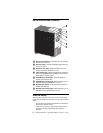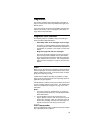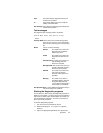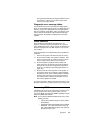12 Netfinity 3500-M20 – Type 8657 Models 21Y, 22Y, 31Y, 32Y,
4. Select either Extended or Basic from the top of the
screen.
5. When the Diagnostic Programs screen appears, select
the test you want to run from the list that appears; then,
follow the instructions on the screen.
Notes:
a. If the server stops during testing and you cannot
continue, restart the server and try running the
diagnostic programs again.
b. The keyboard and mouse (pointing device) tests
assume that a keyboard and mouse are attached
to the server.
c. If you run the diagnostic programs with no mouse
attached to the server, you will not be able to navi-
gate between test categories using the Next Cat
and Prev Cat buttons. All other functions pro-
vided by mouse-selectable buttons are also avail-
able using the function keys.
d. You can test the USB keyboard by using the regu-
lar keyboard test. The regular mouse test can test
a USB mouse. Also, you can run the USB hub test
only if there are no USB devices attached.
e. You can view server configuration information
(such as system configuration, memory contents,
interrupt request (IRQ) use, direct memory access
(DMA) use, device drivers, and so on) by selecting
Hardware Info from the top of the screen.
When the tests have completed, you can view the Test Log
by selecting Utility from the top of the screen.
If the hardware checks out OK but the problem persists dur-
ing normal server operations, a software error might be the
cause. If you suspect a software problem, refer to the infor-
mation that comes with the software package.
Viewing the test log
The test log will not contain any information until after the
diagnostic program has run.
Note: If you already are running the diagnostic programs,
begin with step 3.
To view the test log:
1. Turn on the server and watch the screen.
If the server is on, shut down the operating system and
restart the server.
2. When the message F2 for Diagnostics appears,
press F2.
If a power-on password is set, the server prompts you
for it. Type in the appropriate password; then, press
Enter.
3. When the Diagnostic Programs screen appears, select
Utility from the top of the screen.
4. Select View Test Log from the list that appears; then,
follow the instructions on the screen.


















